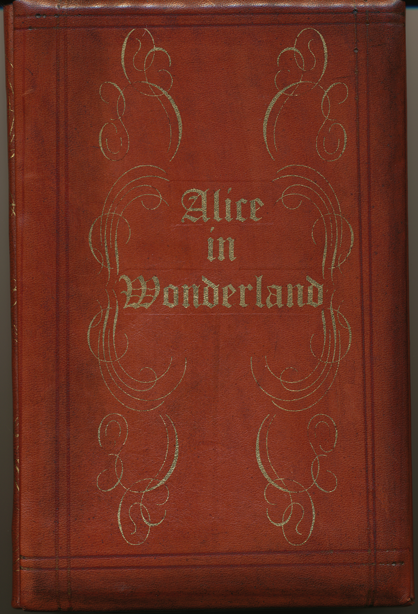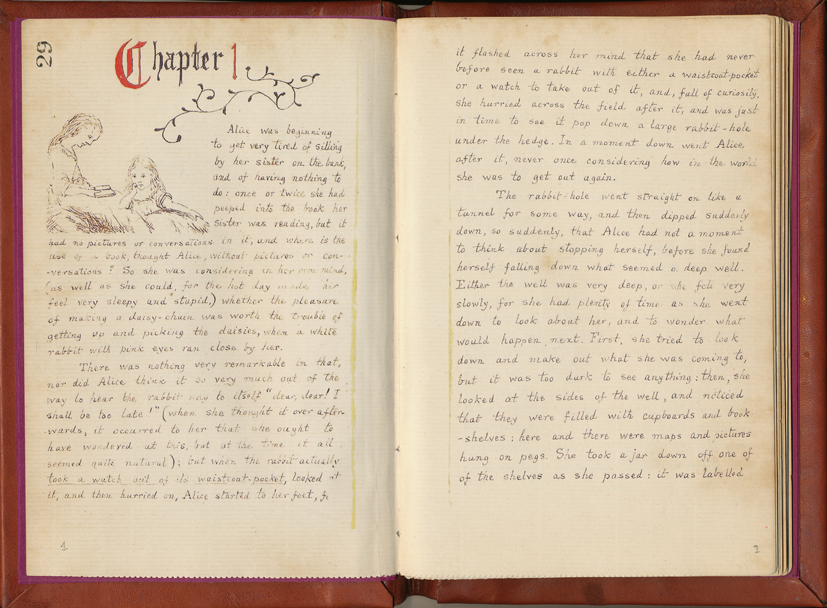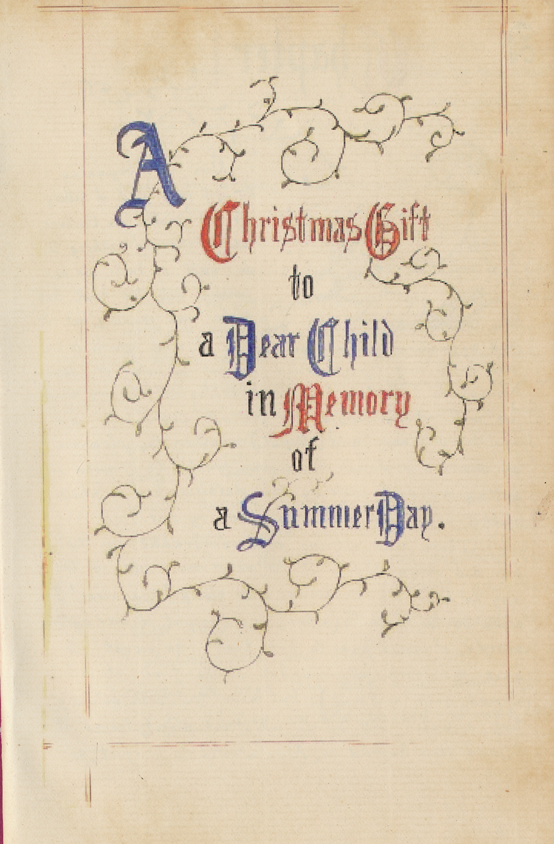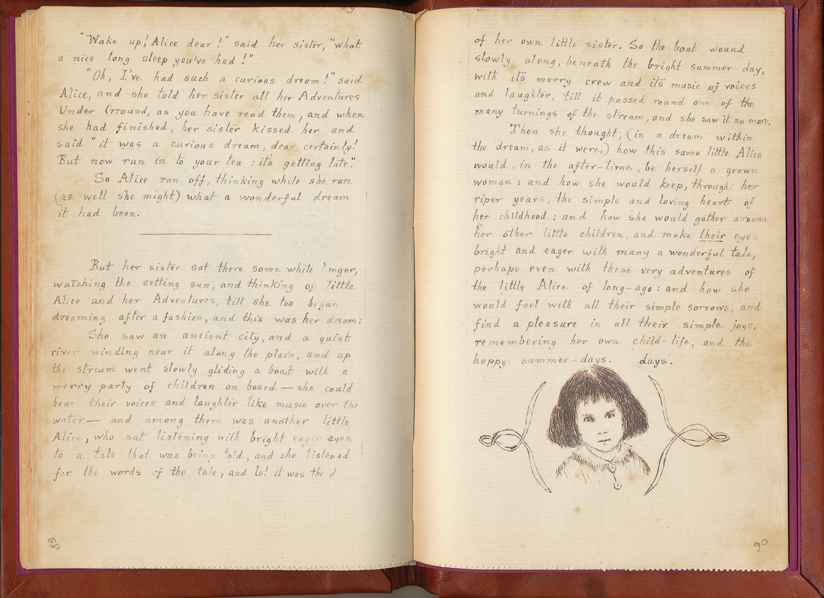Charles Dodgson
Charles Dodgson
Alice’s Adventures Under Ground Facsimile Edition
We have here what is, for us, somewhat of a mystery in the long annals of the publication of Lewis Carroll’s classic, Alice in Wonderland, and in particular its original title, Alice’s Adventures Under Ground. Those wishing a fuller history of the many editions may read further, but our copy appears to be a true facsimile of the original 1864 handwritten edition. It is just 90 pages long, and bears the original drawing of young Alice Liddell—which to our knowledge did not appear in any subsequent editions, having been replaced instead in 1886 with a pasted-down photograph of the real Alice. Ours is a collotype facsimile reproducing the original manuscript text, with 37 color and black and white illustrations by the author, 14 of them full-page drawings. Extensive research has yielded little about this particular edition, though it is quite old, printed on aged classic laid paper with toning throughout, with imperceptibly uneven, scallop-sheared edges and curious number stampings on various pages. More detailed images can be provided to serious buyers. The original manuscript is one of the many literary treasures found in the British Library‘s extensive collection, and the story of how it got there is a fascinating one you will not want to miss—and which you will find here.
We acquired this volume in Venice, Italy, from a master leather craftsman and bookbinder who acquires first and later versions of significant works, removes the original covers and bindings, and lovingly replaces them with custom-made leather bindings—usually embossed or otherwise imprinted with the same or similar cover art, in the fashion of the wealthy classes of an earlier age.
![]()
The story Alice’s Adventures in Wonderland began on July 4, 1862. Charles Lutwidge Dodgson, his friend reverend Canon Duckworth, and the sisters Alice, Lorina and Edith Liddell were on a boat trip on the river Isis (the local name for the stretch of the Thames that flows through Oxford) from Oxford to Godstow. Alice grew restless and begged Dodgson for a story “with lots of nonsense in it”. Dodgson began, and invented the story while he was telling it. Much of the story was based on a picnic a couple of weeks earlier when they had been caught in the rain.
Several times Dodgson tried to break off the story, but the children were not to be put off. They didn’t return at the Deanery until late in the evening. On two other boat trips, Dodgson continued the series of “Alice stories”.
This is how Reverend Duckworth described the trip afterwards:
“I rowed stroke and he rowed bow (the three little girls sat in the stern) … and the story was actually composed over my shoulder for the benefit of Alice Liddell, who was acting as ‘cox’ of our gig … I remember turning round and saying, ‘Dodgson, is this an extempore romance of yours?’ And he replied, ‘Yes, I’m inventing it as we go along.'”
In an article in the New York Times of April 4, 1928, Alice Liddell recalled:
“The beginning of Alice was told to me one summer afternoon, when the sun was so hot we landed in the meadows down the river, deserting the boat to take refuge in the only bit of shade to be found, which was under a newly made hayrick. Here from all three of us, my sisters and myself, came the old petition, ‘Tell us a story’ and Mr. Dodgson began it. Sometimes to tease us, Mr. Dodgson would stop and say suddenly, ‘That’s all till next time.’ ‘Oh,’ we would cry, ‘it’s not bedtime already!’ and he would go on. Another time the story would begin in the boat and Mr. Dodgson would pretend to fall asleep in the middle, to our great dismay.”
In the end Alice asked him to write the story down for her. According to Duckworth, Dodgson sat up all night and sketched an initial outline. Later he expanded it on a train journey with some adventures that had been told on other occasions. He copied it out again, more carefully and in a hand that Alice would find legible, and left spaces for pictures of his own drawings. He called it Alice’s Adventures Under Ground. Dodgson presented the manuscript to Alice as a Christmas gift on November 26, 1864, with illustrations by the author himself, dedicating it as “A Christmas Gift to a Dear Child in Memory of a Summer’s Day”. Some speculate there was an earlier version that was destroyed later by Dodgson when he printed a more elaborate copy by hand. But before Alice received her copy, Dodgson was already preparing it for publication and expanding the 15,500-word original to 27,500 words, most notably adding the episodes about the Cheshire Cat and the Mad Tea-Party.
In 1865, Dodgson’s tale was published as Alice’s Adventures in Wonderland by “Lewis Carroll” with illustrations by John Tenniel. The first print run of 2,000 was held back because Tenniel objected to the print quality. A new edition, released in December of the same year, but carrying an 1866 date, was quickly printed. As it turned out, the original edition was sold with Dodgson’s permission to the New York publishing house of Appleton. The binding for the Appleton Alice was virtually identical to the 1866 Macmillan Alice, except for the publisher’s name at the foot of the spine. The title page of the Appleton Alice was an insert cancelling the original Macmillan title page of 1865, and bearing the New York publisher’s imprint and the date 1866.
The entire print run sold out quickly. Alice was a publishing sensation, beloved by children and adults alike. Among its first avid readers were Queen Victoria and the young Oscar Wilde. The book has never been out of print. Alice’s Adventures in Wonderland has been translated into 125 languages. There have now been over a hundred editions of the book, as well as countless adaptations in other media, especially theatre and film.
The book is commonly referred to by the abbreviated title Alice in Wonderland, an alternative title popularized by the numerous stage, film and television adaptations of the story produced over the years. Some printings of this title contain both Alice’s Adventures in Wonderland and its sequel Through the Looking-Glass, and What Alice Found There.




